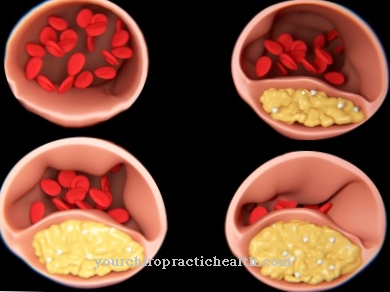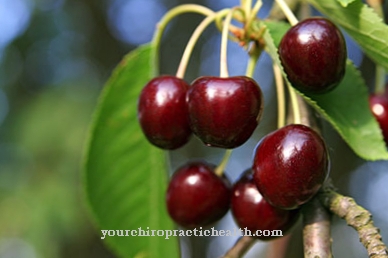A Groin strain arises in most cases from sudden overload while exercising. It can have three different degrees of severity and affects the adductors. A groin strain can be avoided by intensive warming up and stretching of the individual muscle groups and by slow cooling down after exercise.
What is a groin strain?

© Stefan Schurr - stock.adobe.com
Under one Groin strain one understands an overstretching or injury of the so-called adductors by a sudden sideways movement or straddle. Adductors in this case are skeletal muscles and tendons that are used to pull the legs towards you. Their opponents are called abductors. A groin strain is a relatively common sports injury.
It often affects soccer players, hurdlers, swimmers, skiers or ice hockey players. The sports mentioned are characterized by intensive footwork, which can lead to a groin strain. Especially as a competitive athlete, one suffers from groin strains more often.
The severity of the groin strain can be one of three degrees:
The slight strain of the adductor means an overstretching in which less than five percent of the adductor fibers are damaged. You can continue to train with this groin strain, but you will feel pain. The second degree of severity of a groin strain means more than 5 percent muscle fiber tears, which can be felt even with light loads or pressure on the adductors.
Pronounced muscle fiber tears characterize the third degree of severity of the groin strain. This can lead to bruising, swelling and severe, stabbing pain. The healing process will take different lengths of time depending on the severity of the groin strain.
causes
Overuse and sudden overstretching of the legs or abdominal muscles can lead to the so-called Groin strain to lead. The pain occurs on the inside of the thighs when stressed.
Often, a sudden movement while jumping after a ball or over a hurdle is enough to cause a groin strain. The groin strain is also favored by unsuitable footwear, an incorrect jumping or running technique and a sudden sideways movement.
A congenital malalignment of the hips, a pelvic inclination with different leg lengths or a malfunction of the hip joints can be the cause of a groin strain as a further cause.
Symptoms, ailments & signs
A groin strain usually results from an unfamiliar or excessive load on the groin region. This causes the muscles to be pulled, so that the person affected suffers from sharp pain in the groin area. The pain often occurs immediately after exercising. In particularly severe cases, there may even be visible swellings and bruises that can last for several days.
Affected people are very limited in their entire everyday life, so that the quality of life suffers considerably. If the affected person decides to seek medical treatment, a quick and smooth healing can be expected. Groin strains are also noticeable during certain movements, so that this can lead to strong tension. The muscles tense up, so that, under certain circumstances, long-lasting cramps in the groin region can also occur.
Groin strains are usually noticeable in the form of sharp pain and occur immediately after unfamiliar activity. Severe swelling in the affected area is also possible, so medical treatment is essential. Without any treatment, inflammation of the nerves or permanent damage are possible, so that a visit to the doctor must not be put off the long bench.
Course of disease
The course of a Groin strain may vary depending on the severity. With the first degree of groin strain, the pain is often only noticed after exercising. It may be that the groin strain is announced by cramps or that pain occurs when the legs are twisted.
The pain associated with slight adductor strain is load-dependent. In severe types of groin strain, visible bruises and swellings can occur. If you press your legs sideways against resistance, severe pain occurs. With severe groin strain, splaying your legs is extremely painful.
Complications
In the case of a groin strain, the patients primarily suffer from severe pain. These pains can be burning or stabbing and significantly reduce the quality of life and everyday life of the person affected. It is not uncommon for the pain to occur during a groin strain at night and thus lead to sleep problems or irritation in the patient.
Parts of the body can also be affected by swelling, and it is not uncommon for a bruise to occur. The affected person's mobility is also restricted. Due to the groin strain, various activities in everyday life can no longer be carried out easily. The disease sometimes leads to cramps and severe pain. The constant pain can also lead to the development of depression and other mental illnesses in the patient.
A groin strain can be treated well in most cases. There are no particular complications. With the help of various therapies, the symptoms can usually be limited. Life expectancy is not reduced by a groin strain. Only in rare cases are those affected dependent on an operation.
When should you go to the doctor?
If you feel sharp pain in your groin after exercising, you may have a groin strain. A doctor's visit is indicated if the symptoms worsen or other symptoms, such as swelling and bruises, set in. If tension or cramps occur, medical advice is also required. A groin strain heals by itself in many cases, but the symptoms should always be clarified and treated if necessary.
When bruises, chronic pain, and other complications occur, family and friends must take the person to hospital. In the event of severe complaints, it is also useful to call the emergency doctor. Athletes and the elderly are particularly prone to groin strains and should contact a doctor at the first sign. The same applies to people with chronic muscle or bone diseases. If you have been suffering from severe groin pain for a long time, it is best to consult a sports doctor. Other contact persons are the orthopedist, an internist and the physiotherapist.
Treatment & Therapy
At everyone suspected Groin strain you should stop the training, even if it is easy. It must be avoided that the groin strain is aggravated by further overstretching.
Any further ligament stretching at the hip joint intensifies the groin strain. The groin strain is first treated with ice compresses to prevent swelling and hematoma formation. Inguinal strain can be alleviated with compression bandages. This relieves the adductors. Raising the legs relieves the strained thigh muscles. The following treatment for groin strain can be carried out with heat treatments, lymphatic drainage, compression bandages or physiotherapy.
Magnesium administration can support the healing process of the groin strain. In order to heal the groin strain, you should avoid any sporting activity until the healing process begins. Otherwise you risk a new groin strain. Then you can start with moderate exercise training. As long as pain occurs during exercise, the groin strain has not yet healed.
Outlook & forecast
Basically, the prognosis for a groin strain is favorable. The healing phase depends on the severity of the strain. Within about two to four weeks, patients with a slight strain are free of any discomfort if the doctor's instructions on taking sufficient rest and avoiding sporting activities are observed during the treatment phase. If the groin strain is more severe, a healing phase of three to six months must be expected. Afterwards, for a good prognosis, a regulated muscle build-up is necessary, in which the loads are continuously increased. This is the only way to avoid relapse and consequential damage.
A strained performance usually heals completely without complications or other disorders. The prognosis can be worse if the strain occurs in combination with other illnesses (e.g. after a fall or accident). The healing phase can be prolonged and movement can be impaired. Under certain circumstances, these cases can also lead to lifelong mobility restrictions. Physical resilience can also decrease as a result.
Groin strains that occur in competitive sports are often associated with a break of several months. In some cases, the athletes can no longer exercise their sport, which can lead to psychological and emotional problems. This can worsen the overall prognosis.
prevention
The important thing is after a seasoned Groin strain to adjust the movement sequences so that the next groin strain does not occur immediately. Even worse would be a chronic groin strain that can result from too early and intense training.
As a preventive measure to avoid a groin strain, sufficient stretching exercises before athletic loads have proven to be effective. Before every sporting activity and especially before sporting competitions where you push your limits, the muscles should be warmed up thoroughly.
Then they have to be cooled down slowly and stretched again. Good footwear can help avoid a new last strain if the foot is misaligned.
Aftercare
In practice, groin strain is not a disease that requires follow-up care. This is particularly due to the fact that a mild and moderate groin strain heals completely. This results in freedom from symptoms. Possible symptoms cannot arise from such an initial illness. Life-threatening consequences are also excluded.
The follow-up care can therefore not diagnose any possible neoplasms, such as occur in tumor diseases. The situation is different with a severe form. This sometimes leaves scars that encourage renewed groin strain. The reason for a repeated illness, however, is the stress that is familiar from top-class sport. To avoid complications, affected patients should avoid such or similar extreme situations.
Follow-up care for a groin strain takes place mainly through knowledge transfer. The healthcare professional educates patients about ways to avoid the risk of developing a new disease. Stretching exercises and thorough warm-up especially reduce the risk of a groin strain. However, the actual implementation falls within the patient's area of responsibility.
In the event of a recurrence, physiotherapy, heat treatment and drainage promise to alleviate the symptoms. The doctor makes a diagnosis based on the described restrictions of movement and the pain symptoms. If follow-up examinations are necessary, imaging methods are suitable for documentation.
You can do that yourself
In the event of a groin strain, the groin must first be spared and cooled. It is best to put your legs up straight away. Cooling compresses and ice will help relieve pain and prevent bruises. In the case of a slight strain, these measures are often sufficient to ensure rapid healing.
A pronounced groin strain should definitely be treated by an orthopedic surgeon. The doctor will usually suggest further protection and cooling of the groin. Above all, sports that stress the adductors should be avoided. In order to maintain physical fitness, however, strength training can be carried out - of course under professional supervision. Physiotherapy and yoga also help to avoid a drop in performance without a great risk of injury. A change of sports shoes can further reduce the risk of a new strain.
After recovery, the following applies: warm up well before exercise and incorporate a slow cooling phase after exercise, in which the muscles are gradually relieved. If the ligaments and muscles are particularly sensitive, it may also be useful to wear compression pants or warmth pants.


.jpg)
.jpg)


.jpg)




















